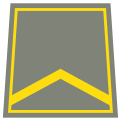Russia
| Mladshy serzhant Младший сержант | |
|---|---|
  Army shoulder and air force sleeve insignia | |
| Country | |
| Service branch | |
| Rank | Non-commissioned officer |
| Formation | 1940 |
| Next higher rank | Serzhant |
| Next lower rank | Yefreytor |
| Equivalent ranks | Starshina 2nd class |
Junior sergeant (Russian : Младший сержант, romanized: Mladshy serzhant) is the designation to the lowest rank in the non-commissioned officer's career group in the Army, Airborne Troops, Naval Infantry and Air Force of the Russian Federation. The rank is equivalent to Starshina 2nd class in Navy.
The rank was introduced in the Red Army in 1940.








